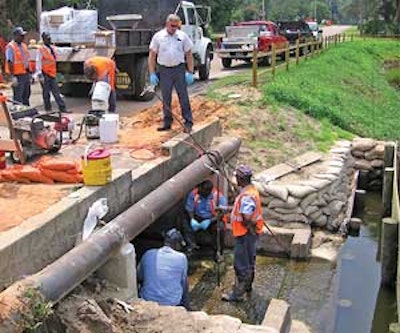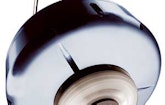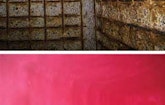Interested in Manholes?
Get Manholes articles, news and videos right in your inbox! Sign up now.
Manholes + Get AlertsExpandable rings raise manholesto grade
Problem
The City of Winston-Salem, N.C., annually raises about 100 manholes to grade. “The risers were somewhat difficult to install because they had setscrews, didn’t seat well, and the lids sometimes rattled and popped out,” says streets supervisor Larry Cauthen. “We needed a product that would reduce our materials, time and labor.”
Solution
The city purchased turnbuckle manhole rings from American Highway Products. The installer sets the galvanized steel ring into the manhole rim, then uses a screwdriver to turn the pivoted turnbuckle plus or minus 0.5 inches. A 60-pound force exerts a 5,600-pound tangential force, locking the ring against the opening and preventing rattles. The one-piece assembly takes five minutes to install and provides a flat surface for seating manhole covers. The rings will not break from uneven seats or installation forces.
Result
“The rings are lighter and easier to handle than the old risers,” says Cauthen. “We also save about $30 in materials per manhole, and our installation costs are less because they go in so fast.” The city has yet to have a ring fail. 888/272-2397; www.ahp1.com.
Lining system adds new life
Problem
A 54-inch ductile iron main in Monroe, La., carries 70 percent of the city’s wastewater to the treatment plant. While the pipe was in good condition, the 30 concrete manholes and five junction boxes were badly deteriorated from hydrogen sulfide. In some places, the concrete was completely missing. After rehabilitating the structures, the city searched for a way to protect the new concrete from the corrosive environment.
Solution
Officials invited Gulf Coast Underground in Fort Myers, Fla., to demonstrate the SpectraShield multi-component stress skin panel liner system from CCI Spectrum Inc. After workers cleaned and abraded the manhole walls, they bored into them and injected fast-acting SpectraGrout to stop severe leaks. They plugged minor ones with quick-setting hydraulic cement.
The first layer of the SpectraShield system is a primer designed for saturated concrete. The thin film provides adhesion to the substrate. After the primer dried for the required four hours, the crew sprayed on a layer of silicone-modified polyurea, followed by a layer of tight closed-cell polyurethane foam to fill voids and restore placement.
The foam dried tack-free in 8 to 12 seconds. The crew then applied a second thin film of silicone-modified polyurea as the final corrosion barrier. It dried just as quickly.
Result
“The only way to know what will work in a corrosive area like this one is to see a product in action,” says head project manager Arthur Holland. “The quick installation and cure time were real selling points.” The city lined all its repaired manholes and junction boxes with the SpectraShield system. 904/704-9786; www.spectrashield.com.
Grout stabilizes box culverts
Problem
Water had established flow paths under a reinforced concrete box culvert in Panama City Beach, Fla., causing the structure to settle and damage the roadway above. City crews filled the voids with concrete, but the heavy repairs quickly sank into the loose soils, causing the culvert to settle further.
Solution
Stormwater director William Scruggs called Ed Paradis, southeast regional manager for De Neef Construction Chemicals Inc. He inspected the culvert, then recommended injecting Hydro Active Cut polyurethane grout into the voids. After training by Paradis, city crews drove two rows of probes on 3-foot centers 6 feet deep on the upstream side of the road. “We didn’t have to halt traffic or set up bypass pumping,” says Scruggs. The lightweight, waterproof grout filled the voids and flow paths under the culvert and stabilized the surrounding soils. The men completed the work in two days.
Result
A follow-up inspection by the city two years later showed no signs of the previous problems. 800/732-0166; www.deneef.com.
Manhole inspection system meets assessment goals
Problem
The City of Tacoma (Wash.) Public Works Environmental Services wanted crews to inspect 100 manholes per week to meet assessment goals and collect data to make effective rehabilitation decisions. The city has more than 12,000 manholes.
Solution
In January 2010, Atlas Inspection Technologies of Seattle demonstrated the Panoramo SI 360-degree manhole inspection system from RapidView IBAK North America. In seconds, two high-resolution digital cameras with specially designed distortion-free wide-angle lenses scanned the interior of a manhole in one vertical run. The system allowed operators to stop the scan in any position, do a 360-degree pan-zoom, take snapshots, and generate an unfolded view of the structure. The 3D point cloud feature let them measure nearly any feature, then export the data to a CAD program.
Result
The demonstration team inspected 41 manholes in 4 hours and 22 minutes, averaging 9.46 manholes per hour and proving to the city that its goal was attainable. 800/656-4225; www.rapidview.com.
Manhole replacement without excavation
Problem
The manholes near City Hall in Hampton, Va., were severely deteriorated from high levels of hydrogen sulfide gas. The city tested ConMICShield liquid concrete preservative from AP/M Permaform in a comparison of two manholes.
Solution
City crews assembled lightweight steel panels inside the manholes, then poured vibrating high-strength AP/M Permaform concrete into the 3-inch space between the form and wall. They added the U.S. EPA registered antibacterial agent to the mix for the first manhole. The liquid kills sulfuric acid-producing bacteria on contact, and its molecules bond to the cement particles so it cannot wash off, chip off, peel off, delaminate, or pinhole.
Result
After five years, the corrosion-protected manhole showed no sign of deterioration, but the unprotected one had severe structural damage. 877/543-2094; www.conshield.com.
Concrete rehabilitated with epoxy lining
Problem
Jacksonville (Fla.) Naval Air Station, along the St. Johns River, has a high water table. Water coursing into corroded box culverts, catch basin vaults, and storm drains eroded the surrounding soil, causing roads to sink and creating potholes. Infiltration of sand and mud restricted flows, creating backups that flooded parking lots and sometimes buildings. Unwilling to close the heavily traveled roads, the Navy filled and paved over the sinkholes to keep traffic moving.
Solution
Officials began an extensive program that included rehabilitating the structures with Epoxytec CPP (concrete polymer paste) from Epoxytec International Inc. The coating has no volatile organic compounds that could contaminate the river. It also has high moisture tolerance, adheres to wet concrete, and cures submerged in water.
A two-man crew from Engineered Lining Systems Inc. (ELS) in Jacksonville removed compromised liners, then prepared the underlying concrete to specifications. As part of the resurfacing process, some areas were rubbed down with Hydrxx-3 quick-curing hydraulic paste for filling large voids. Once the mortar dried, the men troweled on a 1/8-inch-thick layer of CPP. The two-part epoxy liner dried in 30 minutes.
Result
Rehabilitating the structures has reduced I&I, erosion and sinkholes on the base. “The walls of the structure do not have to be dry before applying Epoxytec CPP,” says ELS vice president Gary Pender. “Having moisture-tolerant products is very important in Florida’s damp environment.” 877/463-7699; www.epoxytec.com.
Structural lining stops surcharges and infiltration
Problem
Infiltration and a new service tying into a sewer in Palm Beach, Fla., caused a deteriorated brick manhole to surcharge. Workers found that hydrogen sulfide gas had eroded the bench and inverts. The city wanted the manhole rehabilitated quickly.
Solution
SAK Construction of Palmetto, Fla., turned to SprayWall, a 100 percent volatile organic compounds-free self-priming polyurethane coating from Sprayroq Inc. After pressure washing the manhole at 3,000 psi, a certified company technician applied a hydraulic cementitious mortar, providing a smooth substrate for the lining. He also created a new bench and trough for a smooth transitional channel.
To stop inflow and infiltration, the technician drilled a 1-inch hole at the intrusion points, then pumped in acrylamide grout with a topcoat of Octoplug mortar from IPA Systems. After mixing the A and B components, the technician sprayed the coating on the manhole walls. The coating gelled in about 8 seconds and was tack-free after one minute. The initial cure occurred in 30 minutes, when the manhole was returned to service. The curing process continued for 4 to 6 hours.
Result
The manhole has a monolithic, corrosion- and abrasion-resistant surface. The walls are rigid enough to withstand vacuum truck tubes and workers dropping sharp tools against them. 800/634-0504; www.sprayroq.net.
Liner system stops severe infiltration
Problem
Infiltration was pouring in around the riser joints and bench area of a precast manhole in a subdivision of Wilsonville, Ore. The city hired several contractors to repair the structure with chemical grout, but the fix proved only temporary.
Solution
The city contacted sewer rehabilitation specialist Jim Atchison of SunCoast Environmental Northwest in Vancouver, Wash. He proposed lining the manhole with Poly-Triplex three-ply fiberglass-reinforced liner from Poly-Triplex Technologies. Workers stopped the infiltration with chemical grout and hydraulic cement, then cleaned and prepared the manhole walls. The custom-made PTLS-6800 liner has an internal nonporous PVC membrane layer, which the crew impregnated with a two-part epoxy resin that cures even in wet conditions.
Once the liner was in position, they applied air pressure sufficient to offset hydrostatic head pressure and injected steam at 300 degrees F to speed curing. The procedure expanded a removable inflation bladder that forced the liner into gaps and bonded it to the walls and benches. The liner cured in less than two hours, and the bladder was removed.
Result
Stopping the infiltration saved the city thousands of dollars in treatment costs. The problem has not recurred. 850/547-9999; www.poly-triplex.com.
Tightening pump station run times
Problem
One-third of the 400 or more pump stations in the City of Virginia Beach, Va., combined wastewater/stormwater conveyance system had excessive run times from inflow and infiltration. After smoke testing, dye testing and flooding, camera inspection, and hydraulic analysis, the city estimated that 85 percent of the stormwater inflow came from faulty laterals.
Solution
Using pump station SCADA information, the city ranked them according to run times and number of service calls. Remediation included installing mainline and lateral cleanouts and Rainstopper manhole inserts from WBE Dorcas Inc. to reduce stormwater inflow through manhole covers.
Available in HDPE plastic or stainless steel, the pan-like devices fit on the lip of the manhole to catch runoff, while sewer gas vents through a nonmechanical device. The units are easy to install and have no moving parts.
Result
Rainstorms on June 17 and July 5, 2008, were similar to the 1.56-inch rainfall on April 22, 2008. The reduction in flow at two stations was 442,500 gallons. 719/686-5988; www.wbedorcas.com.













